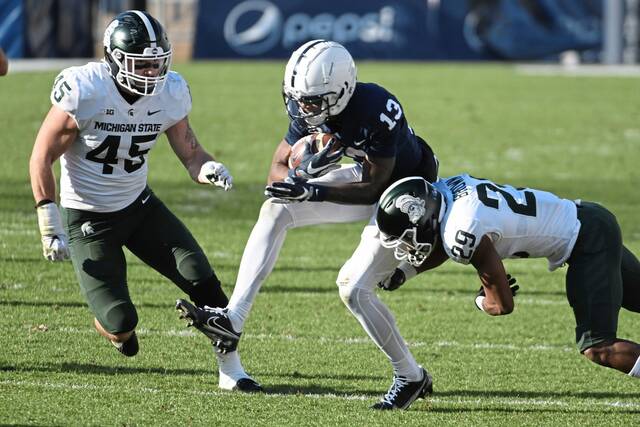https://naviga.triblive.com/sports/penn-states-wide-receiver-depth-makes-positions-once-troubling-instability-feel-like-distant-memory/
Penn State’s wide receiver depth makes position’s once-troubling instability feel like distant memory

It wasn’t all that long ago Penn State was going through a “churn” at the wide receivers coach position and started making the wrong kinds of headlines about the way the program was developing its playmakers.
David Corley lasted just the 2018 season coaching wideouts, and Gerad Parker spent the following season in Happy Valley before jumping at the opportunity to be the offensive coordinator at West Virginia.
Meanwhile, former five-star prospect Justin Shorter had a hard time translating his potential into production and transferred to Florida, and another five-star talent in the 2020 class, Southern Columbia’s Julian Fleming, was brutally honest in his assessment of Penn State’s wide receivers room after committing to Ohio State.
“They weren’t stable on offense, defense; they weren’t pulling out games; their coaching has been unstable for the past couple years,” Fleming said after announcing his commitment to Ohio State. “A lot of stuff weighed into it.”
Throw in the transfers of Florida natives John Dunmore and T.J. Jones, and Penn State’s depth and reputation were in question.
Penn State announced the hiring of Taylor Stubblefield in January 2020 to try and break those trends, but stability was a question with him, too. He spent 13 seasons as a wide receivers coach at 10 places, though coach James Franklin indicated that Stubblefield had concrete reasons for most of those quick departures.
Still, Penn State needed a stable voice, and Stubblefield needed a lasting home.
“We need stability,” Franklin said shortly after Stubblefield was hired. “The interesting thing is he needs it, too. One of the stories that a lot of people have talked about is he hasn’t necessarily shown that in his career. So something that he needs and we both need right now. So I think that helps.”
Stubblefield’s first year on the job was impacted by covid, but hope emerged when Jahan Dotson officially broke out and then-freshman Parker Washington looked like a young star in the making. Both those trends continued last season, but Penn State also developed KeAndre Lambert-Smith into a legitimate No. 3 option and offered reasons to be optimistic about young wideouts that included physical marvel Malick Meiga and freshman Trey Wallace.
The stability Franklin sought has emerged by developing much-needed Nos. 2 and 3 options in Washington and Lambert-Smith, both of whom were part of Stubblefield’s first recruiting class at Penn State. The development of Dotson into a star also bodes well for Washington as he looks to make the jump into a No. 1 alongside a new running mate in Western Kentucky transfer Mitchell Tinsley.
Three years of quality recruiting at the position have Penn State’s wide receivers room brimming with as much talent as ever. It still skews young, but the competition should be fierce for spots on the two-deep this fall. Even freshman speedsters Kaden Saunders and Omari Evans have a shot to contribute.
“Quite frankly, this is the longest I’ve ever been at a place, too,” Stubblefield said. “That’s helped. I think we’ve recruited well these last few years. I think we’ve developed here these last few years, and we have a chance with this group to be the deepest it’s been in a long time. Obviously, there’s still development that needs to happen, but we are excited about this group.
“We still have some unknowns, but in terms of somebody you look at in the room like, ‘I don’t really know about that guy,’ I don’t think we have that guy right now.”
Penn State has 11 scholarship wide receivers currently listed on its roster, which includes four freshmen from a big 2022 class and a pair of redshirt freshmen in Wallace and Liam Clifford. Redshirt sophomore Jaden Dottin is showing signs in Year 3 that he could become a factor soon as the Lions’ young veterans at the position look to stave off the freshmen at training camp.
Losing Dotson to the NFL Draft was a blow the Penn State coaching staff knew was coming, and they adjusted by plucking Tinsley out of the NCAA transfer portal. Stubblefield said they did all their homework before making that move and adding a much-needed veteran who can give the program time to develop its younger options. Again, stability was a theme.
“We talked with his junior college coaches, and we tried to dig into what kind of person he is because he has one year, and sometimes those guys are coming in just to be strictly as a ‘me’ guy, ‘me, me, me,’ ” Stubblefield said. “So, you’ve kind of got to navigate that, and Mitch is not that. It is hard, but it’s just another part of recruiting and I think obviously we haven’t played a season, but I’ve been very impressed with what Mitch has brought to the table.”
Tinsley has fed into that theme of stability, which is now part of a more sophisticated recruiting pitch Stubblefield says he can make to prospects. His position’s track record is now an asset, not a liability, and he can use it to his favor.
Times have changed in Penn State’s wide receivers room, as both the program and Stubblefield have found the steady ground they’ve needed.
“I’m able to tell guys, ‘You have a chance to be like some of the guys we have in our room,’ ” Stubblefield said. “You’ll either be able to learn from them or push them, so when it’s your time — and that time could be as a freshman, it could be as a sophomore — whenever your time is, you’ll be able to replicate or even go above and beyond the guys that have come before you.”
Copyright ©2025— Trib Total Media, LLC (TribLIVE.com)
